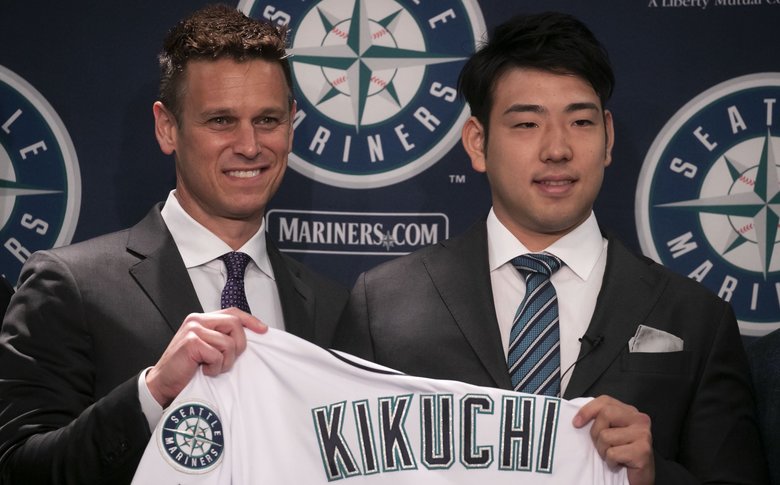For the Mariners, this offseason has been all about a tearing down — of their roster, and of short-term hope.
And now, after a steady stream of key departures, each one a dagger to the hearts of their fans, finally comes a moment for them to embrace an arrival, with no strings attached.
Oh, each of those aforementioned deals that constituted the essence of Seattle’s roster “re-imagination” — code word for decimation – certainly brought back prospects to dream about. But those are to be the payoff down the road, the deferred gratification used to justify the loss of James Paxton, Robinson Cano, Edwin Diaz and all the rest.
The understanding, the trade-off, and the burden of such rebuilding projects is that the present is guaranteed to be messy.
Left-handed pitcher Yusei Kikuchi, signed by the Mariners to an innovative four-year deal Wednesday, is the gift that doesn’t have to be stored in the closet until next Christmas. It isn’t accompanied by a corresponding (and deflating) departure, unless you count the $14 million a year the Mariners are sending his way over the next three, four or seven years. And you shouldn’t.
If all goes well, Kikuchi will provide joy and benefits both now and in the future, a salve for the dark days presumably ahead in 2019, and a bridge to what general manager Jerry Dipoto promises will be the rising in a couple years.
Like all Japanese players, of course, Kikuchi arrives with an air of mystery — but that’s only fitting with this ambitious and risky retooling plan. These Mariners are a team Nancy Drew would love.
Will Kikuchi, an ace in Japan for the Seibu Lions, be Shohei Ohtani, an instant sensation, or Hideki Irabu, an overhyped bust? And even if he achieves early success, will he succumb to the so-called Third-Year Wall, a tendency for Japanese pitchers to sparkle for two seasons and then hit a rapid decline, either via injury or poor performance? Hideo Nomo, Daisuke Matsuzaka, Yu Darvish, Masato Yoshii and Kazuhisa Ishii are cited as examples of this phenomenon.
The Mariners’ most recent Japanese pitcher, Hisashi Iwakuma, came here at age 31 with shoulder issues and struggled to adjust to the throwing program. But he had four solid seasons (one interrupted by injury) before hitting a wall of sorts. After missing all of last season from shoulder surgery, Iwakuma is attempting a comeback in Japan.
Masahiro Tanaka, with five solid years for the Yankees on his resume and still going strong, is proof that breakdown doesn’t have to be the outcome.
The Mariners had better hope not, because Kikuchi is being billed as one of the pieces the M’s hope to rally around if and when they transition into contention. Kikuchi is just 27, so that is a feasible plan if the transition occurs in two or three years, as Dipoto is now proposing — less so if it takes longer, which is a more realistic scenario.
On the surface, it seems incongruous for a team in tear-down mode such as the Mariners to spend so much — a minimum of $43 million or a maximum of $109 million (depending on whether Kikuchi opts out after three years, exercises an option for a fourth year or the Mariners after three years exercise a built-in four-year extension; like I said, the deal is innovative).
But incongruity has been a byword for a Seattle team that traded so many major parts after winning 89 games — rightly so, in my opinion. It takes supreme confidence to hitch your wagon to a pitcher unproven in MLB, on the premise that he will still be in his prime when the Mariners’ darkness turns to light.
As with this entire blueprint, much could go wrong. Supreme confidence could turn out to be supreme foolishness. In that way, Kikuchi is much like all those blue-chip prospects that Dipoto is amassing. They all sound good in the abstract, but this entire rebuild is predicated on the Mariners having chosen wisely in the pieces upon which they are banking everything.
We’ll have to wait to find out the answer to that. As Mariners fans know all too well, this organization has a history of backing the wrong horse. But at least it’s possible now to see the faint outline of a potential future rotation glittering with promise — Kikuchi, Marco Gonzales, Justus Sheffield (acquired from the Yankees in the Paxton trade), Erik Swanson (ditto) and Justin Dunn (acquired from the Mets in the Cano/Diaz deal).
Kikuchi had a brilliant year in 2017, leading the Pacific League with a 1.97 ERA, compiling a 16-6 record and finishing as runner-up for Japan’s equivalent of the Cy Young Award. Last year, his ERA rose to 3.08 and his strikeouts dropped from 217 to 153 in 24 fewer innings — but he still went 14-4.
Kikuchi also missed time in 2018 because of shoulder issues, not for the first time. According to the Japan Times, the Lions have three times attributed a stint in the minors to Kikuchi’s left-shoulder issues — either pain, inflammation or stiffness — and he has once been sidelined for elbow discomfort.
A representative for his agent, Scott Boras, said at the winter meetings that the shoulder issues are overblown. The Mariners are obviously satisfied enough with his health to make a substantial financial investment.
The M’s certainly didn’t have anyone like Kikuchi in their farm system when the offseason began. Now they have a pipeline of promising rotation arms.
Pipes burst, and so, all too often, do the swelling hopes and dreams attached to pitching prospects. But for one day, at least, it was appropriate to ponder the possibilities of a new Mariners addition in 2019, and not lament yet another departure.



